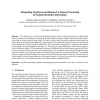Free Online Productivity Tools
i2Speak
i2Symbol
i2OCR
iTex2Img
iWeb2Print
iWeb2Shot
i2Type
iPdf2Split
iPdf2Merge
i2Bopomofo
i2Arabic
i2Style
i2Image
i2PDF
iLatex2Rtf
Sci2ools
116
Voted
JCNS
2000
2000
Integrating Top-Down and Bottom-Up Sensory Processing by Somato-Dendritic Interactions
The classical view of cortical information processing is that of a bottom-up process in a feedforward hierarchy. However, psychophysical, anatomical, and physiological evidence suggests that top-down effects play a crucial role in the processing of input stimuli. Not much is known about the neural mechanisms underlying these effects. Here we investigate a physiologically inspired model of two reciprocally connected cortical areas. Each area receives bottom-up as well as top-down information. This information is integrated by a mechanism that exploits recent findings on somato-dendritic interactions. (1) This results in a burst signal that is robust in the context of noise in bottom-up signals. (2) Investigating the influence of additional top-down information, priming-like effects on the processing of bottom-up input can be demonstrated. (3) In accordance with recent physiological findings, interareal coupling in low-frequency ranges is characteristically enhanced by top-down mechanism...
| Added | 18 Dec 2010 |
| Updated | 18 Dec 2010 |
| Type | Journal |
| Year | 2000 |
| Where | JCNS |
| Authors | Markus Siegel, Konrad P. Körding, Peter König |
Comments (0)

